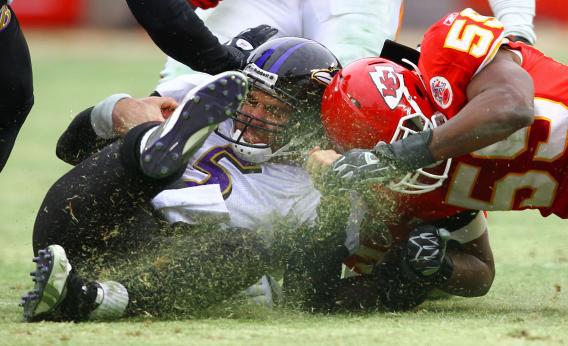Jovan Belcher’s crime is hard to comprehend. How can someone pick up a gun and shoot, multiple times, a woman he purports to love over what reports suggest was a fairly typical couple’s disagreement? (Deciding to end his own life rather than accept the consequences of his actions is, I’m afraid, a bit easier to understand.) It makes sense that, when faced with such unimaginable horror, we cast around looking for easy explanations. Now that brain trauma in NFL players has become such a national issue, it’s tempting to try to find links between the murder and brain injury. Many commentators took this bait, including Katie Halper at Feministing, who on Monday wrote: “What we do know, though, is that neither internal problems in the couple’s relationship nor Belcher’s internal psychology can explain the horrific events, but rather the twin tragedies of traumatic brain injury and gun availability.”
Halper’s reason for believing that Belcher’s act was somehow different from the scores of men who murder their female partners is entirely insufficient: What we know of Belcher doesn’t comport with our image of what men who hurt women are like. She quotes Derek Flood of the Huffington Post saying Belcher didn’t fit “the profile” of an abuser, and citing his participation in college anti-violence programs and the fact that his friends and colleagues—who didn’t live with him—thought he seemed like a nice guy.
Most people thought O.J. Simpson was a nice guy too. Sean Penn is a humanitarian, but he is also the guy who reportedly beat and held his then-wife Madonna hostage for nine hours. Nearly a quarter of all women and 11.6 percent of men report experiencing abuse in their lifetimes; if people prone to domestic violence were that easy to spot, victims would do a better job of avoiding them in the first place.
We don’t know if Belcher ever abused Kasandra Perkins before he murdered her, but what we do know is that domestic violence is, by its nature, a crime that largely happens behind closed doors to victims who are highly motivated to deny that they’re being victimized. Thirty percent of women murdered a year are killed by intimate partners. I feel safe in assuming that none of those women thought that their partner was going to kill them when they first were getting to know him. Most abusers can convince their victims after they’ve beat them that they’re not the hitting types, so why wouldn’t they be able to convince outsiders who haven’t seen their private, violent side?
As much as I would like to believe that such terrible acts of violence have a simple explanation, domestic violence is clearly a complex problem that defies easy fixes. By focusing on concussions and entirely hypothetical brain injuries, we run the risk of downplaying the true nature of these crimes—that they are almost always a result of an abusive partner who puts his desire for control over all other concerns—and of misplacing the blame.
I do agree with Halper on the gun issue. While many men do kill their female partners without guns, the ease with which a gun allows a man who has worked himself into a rage to snuff a life means far more death than would otherwise happen. As Travis Waldron at Think Progress explained:
A domestic dispute in any home may leave a woman bloody and bruised, but in a home without a gun, it’s far less likely to leave her murdered. The presence of a firearm in the home increases the risk of homicide for women by five times, according to one study, and two-thirds of women killed with guns each year die in domestic disputes. When a domestic dispute involves a firearm, it is 12 times more likely to end in homicide.
There’s no simple answer to the Belcher case, or to the many horrible non-celebrity cases like it, but there is no reason for the mass proliferation of tools that make it easy for violent people to maximize their damage.
